Warts on Dogs: Pictures + Pointers on Pesky Papillomas
Remember, this is an educational resource, not a guide for diagnosis.
Pictures are helpful, but they may not tell the whole dermatological story. We always recommend consulting with your vet for any of your dog's health concerns.
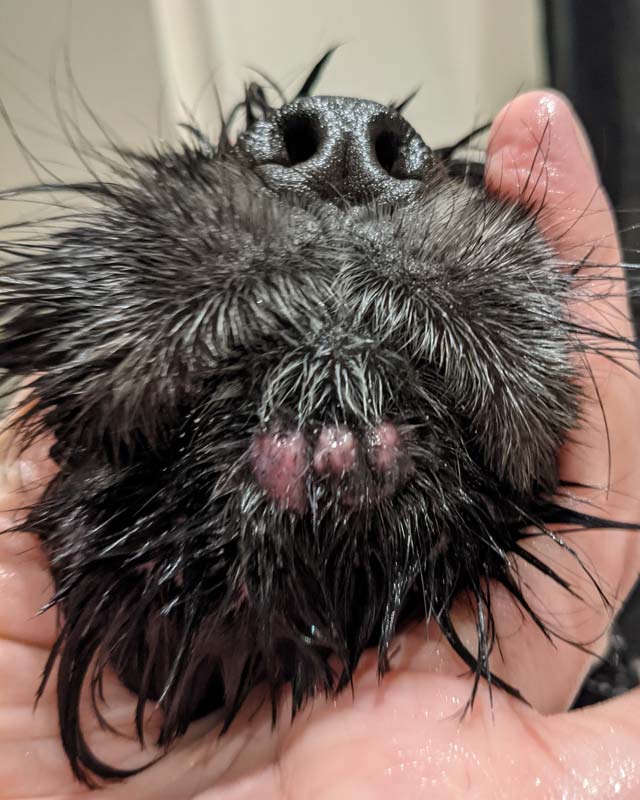
What Are Warts and What Causes Them in Dogs?
Warts, or papillomas, are benign skin tumors caused by the papilloma virus. The papilloma virus comes in many forms and occurs in all animal species, including humans (HPV) and canines (CPV). The virus even has various forms within each species of animal.
Once papilloma viruses invade the skin cells, they upset the normal cell division process and cause them to divide at a faster, abnormal rate. They do this by triggering the DNA's growth-promoting genes, deactivating the genes that limit cell multiplication, and altering the genes that manage the typical programmed cell death process.
Any dog can get warts, but they appear more frequently in puppies, seniors, dogs with suppressed immune systems, or, simply, those that are often around other dogs. Once a dog has been infected with a papilloma virus, they develop immunity to that type - but not other types of CPV.
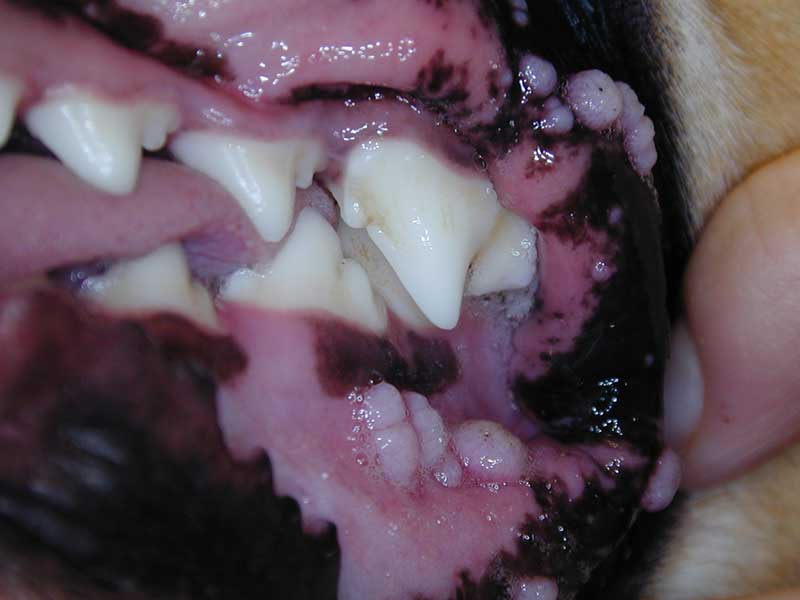
What Do Warts Look Like on Dogs?
Papillomas in dogs can take on many forms and occur nearly anywhere, including in and around the mouth, on the genitals, eyelids, ears, and on the feet between toes. They typically appear with a classical "cauliflower" or feathery "sea anemone" appearance - sometimes with scaly plaques. There are also rare forms that grow inward and form a hard mass.
Warts may appear individually, or in clusters. Young dogs tend to get oral papillomas on the muzzle and mouth, including on the gums and inner side of the "lips."
It's important to note that when warts appear on the skin as solitary papillomas, they can be easily confused with other tumors and growths, like mast cell tumors, follicular cysts, carcinomas, melanomas, and especially sebaceous adenomas. It's always best to let your vet take a look to be sure.
Photo: Clusters of papillomas on dog's gums, via Animal Medical Hospital of West Vancouver
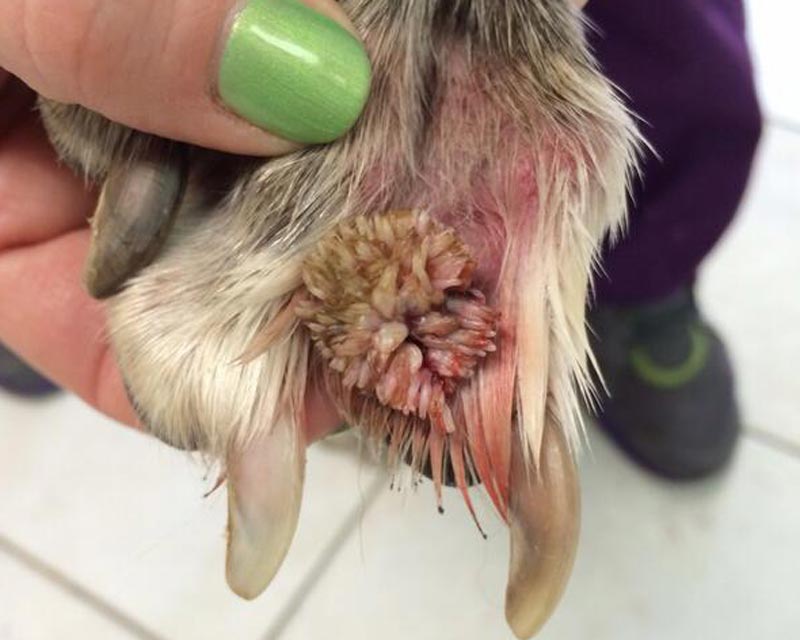
How Do Dogs Get Warts?
Warts are caused by the canine papilloma virus (CPV). CPV is highly contagious to other dogs and can be transmitted via direct contact with an infected dog or items in the environment that the infected dog has touched, such as bedding, toys, food bowls, etc.
From there, CPV gains access to the body through damaged skin, cuts, scrapes, insect bites (mosquitos, fleas, etc.), or naturally moist areas of skin, such as the mouth. If the virus isn't countered by the immune system, warts develop 4 to 6 weeks after infection. In healthy dogs, the papillomas tend to be localized and do not spread to other parts of the body.
Photo: Large anemone-like papilloma between dog's toes; photo by Kelsey O'Brien (@knockout0603), on X
Dog Breeds Prone to Papillomas
Though any breed of dog can have warts, there are a few that seem to be at an increased risk.
-
Pugs
-
Shar Peis
-
Cocker Spaniels
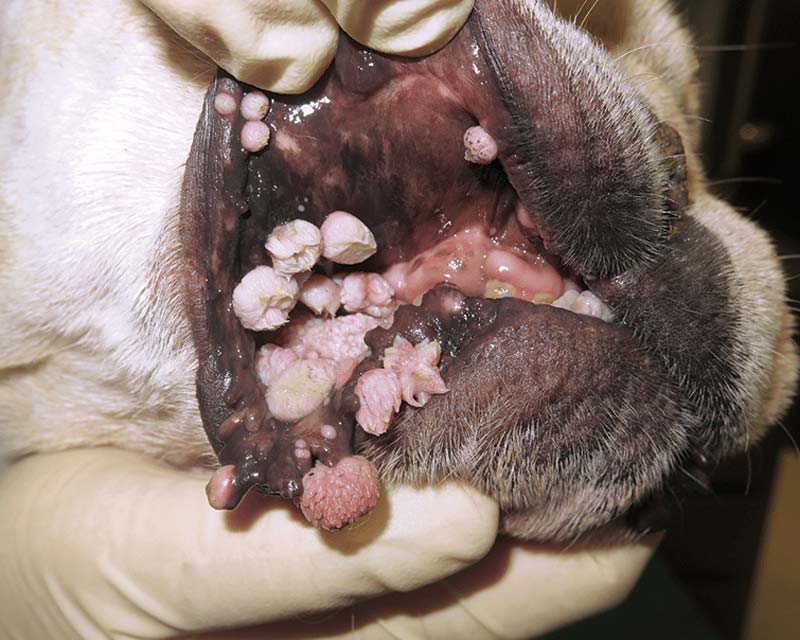
How Are Warts Diagnosed in Dogs?
Most of the time, a veterinarian can diagnose a wart with a simple physical examination, especially if the lesion exhibits the classical cauliflower shape and form.
To be more definitive, vets can perform a fine needle aspiration (FNA), which uses a small needle and syringe to draw a sample of cells from the tumor for analysis. Even more accurate than an FNA is a biopsy of the tumor, in which part, or sometimes all, of the tumor is removed and examined under a microscope (also called histopathology).
Photo: Papillomas on inner lips of pug, via Today's Veterinary Nurse
Treatment for Dog Warts
In healthy dogs, warts don't always need to be removed. They generally disappear on their own over a period of one to two months as the dog forms an immunity to the virus.
There are, however, cases when warts should be treated or removed:
- When the warts are so large, numerous, or ill-located that they cause eye irritation or hamper walking or the ability to eat and drink.
- The dog repetitively scratches or licks at the wart, causing it to bleed and create a risk of bacterial infection.
- Dogs with compromised immune systems or health complications that call for immunosuppressant drugs that render them unable to be rid of warts on their own.
- The wart has not resolved on its own after 3 to 5 months; there is a slight risk of becoming a cancerous tumor.
For a single or small number of warts, surgical removal is most common, either with a scalpel, laser, or cryosurgery (freezing). For cases involving a large number of warts, dogs have been historically treated with oral or injected medications that stimulate the immune system, topical antivirals, or oral medications cimetidine and azithromycin.
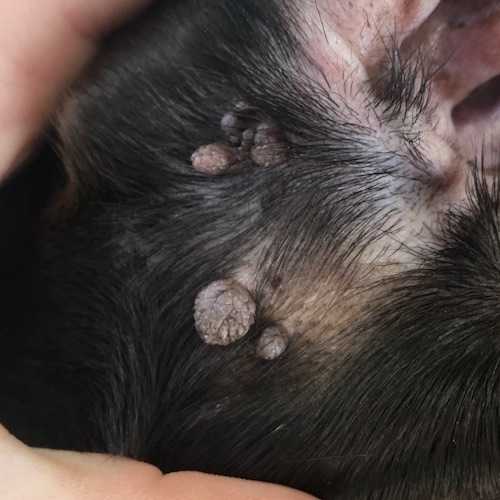
Caring for Canine Warts at Home
It's important to keep your dog from aggravating the warts, as they could potentially rupture, bleed, and become inflamed and infected. Due to the ease of CPV spread, you'll also want to keep them away from other dogs until the warts disappear.
If your dog has any warts surgically removed, it's vital to keep the site clean and likewise protected from irritation. This is where Lavengel® and a bandage would be of service. Our gel would provide irritation relief and help heal the skin and protect the site from bacteria.
There are some at-home wart removal products available on Amazon and other retailers. However, we must insist that it is best to consult with your vet before trying one of these methods. It may be that the wart will resolve itself, or that the thing you seek to remove is not a wart at all and may be something more serious.
Photo: Warts on dog's ear; via Walkerville Vet
Does Lavengel® Help With Dog Warts?
Lavengel® seems to have an effect on the wart tissue, and may help with reducing wart size, but we are not currently sure if it has an effect on the canine papilloma virus (CPV). Here is one customer testimonial that we do have, with corresponding before and after photos above:
"I have been applying it [Lavengel] regularly to the warts on my dog's chin. Compared to the initial outbreak where they were red and quite swollen, the redness is gone, and they appear somewhat smaller. Occasionally, a new one begins, so I cover it with Lavengel, and after a few days, it seems to recede.
Although it's important to point out they don't entirely disappear, they definitely seem to be less angry looking. As for the warts on his bottom, those are deep and hard under the skin, so it will take a while for those to clear. But when they do, as a couple have, they break apart and fall off. With daily continued application, I hope to see that eventually that will clear up."
Dog Wart + Papilloma FAQs
What are canine warts and what causes them?
Warts, or papillomas, are skin tumors caused by the papilloma virus; in dogs, this is the canine papilloma virus (CPV).
CPV invades skin cells and disrupts their routine cell division process, causing them to divide at a higher rate. Over time, this forms growths with a rough, cauliflower-like appearance.
Are dog warts contagious?
The virus that causes warts in dogs, canine papilloma virus (CPV) is very contagious, but only to other dogs.
It is acquired by direct contact with an infected dog, or with something the infected dog has touched, such as bedding, clothing, food bowls, or toys.
Areas like dog parks, kennels, and shelters are places where the virus and other skin diseases like ringworm are often spread. It's best to avoid these places if your dog has an open wound, rash, or if their immune system isn't functioning properly.
Can I get warts from my dog?
No, the canine papilloma virus (CPV) that causes warts in dogs cannot be transmitted to humans or other animals.
We humans have our own version: human papilloma virus, or HPV. HPV, likewise, cannot be transmitted to dogs or other animals.
Will my dog's warts go away on their own?
Generally, yes, canine warts will go away on their own in 1 to 2 months.
Dogs with healthy immune systems will eventually develop an immunity to the papilloma virus, and the warts will disappear.
Should I get my dog's warts removed?
You should consider having your dog's warts removed if:
- They are large or very numerous.
- They are located in a sensitive place or receive constant contact/pressure.
- Your dog won't leave the wart(s) alone.
- The wart is bleeding or become infected.
- The wart does not go away on its own within 3 to 5 months.
How long will my dog be contagious with warts?
Generally speaking, the canine papilloma virus (CPV) that causes warts is contagious as long as the warts are present, as the virus is spread via contact with them.
Most healthy dogs can develop an immunity to the virus within one to two months. It's best to keep them away from other dogs until the papillomas (warts) are gone.
Can I remove my dog's warts by myself at home?
There are some products that advertise canine wart removal. However, it is important to consult with your vet before attempting to use such a product.
Here are 3 reasons why:
- Dog warts tend to go away on their own within 2 months.
- You may hurt your dog.
- Your vet will be able to verify that the tumor is indeed a wart and not something more serious.
More Canine Skin Conditions
-
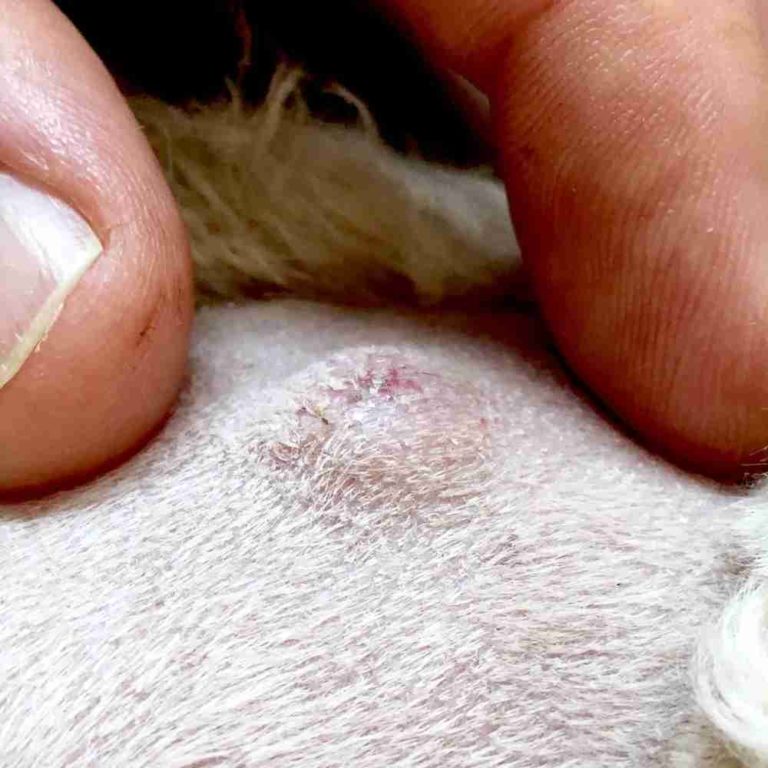
Cysts
Cease and de-cystLike warts, these pesky pockets of semi-fluid matter aren't itchy, but they can be problematic depending on their location.
-
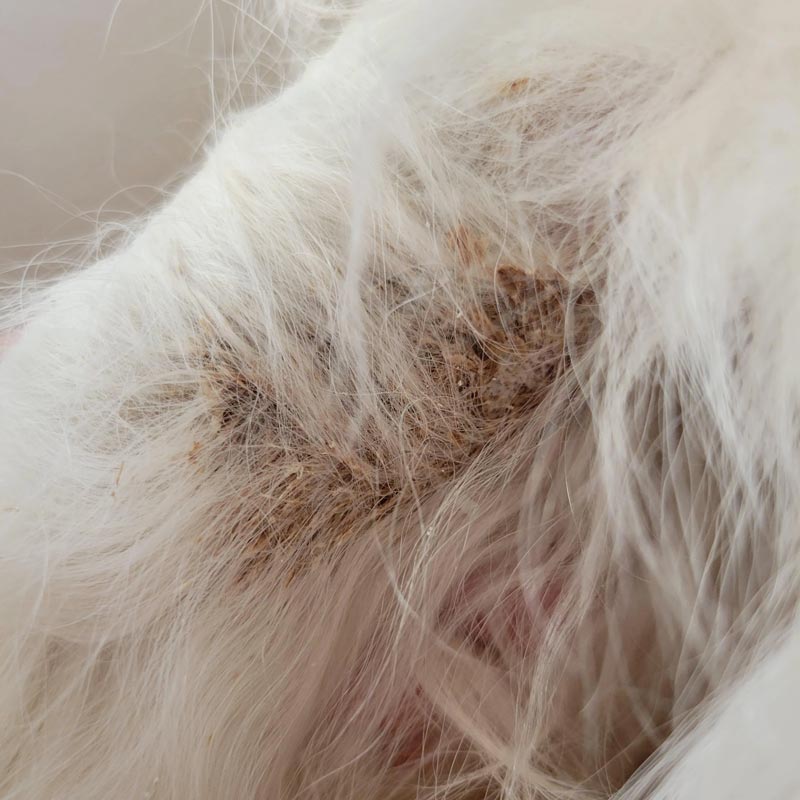
Seborrhea
Distrust this crustSeborrhea appears as excessive dandruff and thick, yellowish crusts that buildup on the skin due to an overproduction of keratin.
-
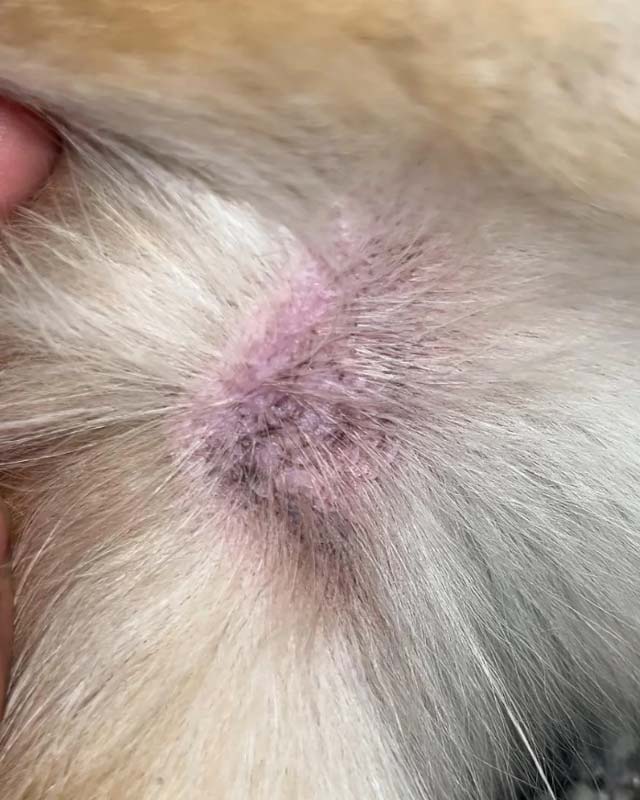
Rashes + Dermatitis
Let's be rash-ionalDermatitis, or inflammation of the skin, comes in many shapes, flavors, and locations. We discuss 11 common types with photo examples.



